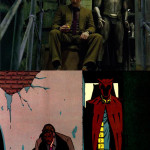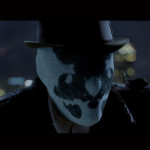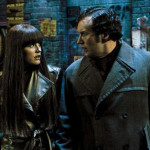WATCHMEN & THE LIMITS OF ADAPTATION
“Who watches the Watchmen?” is a catchphrase from the film Watchmen directed by Zach Snyder. It is graffiti sprayed across an alley wall and it signifies dissatisfaction with the actions of the group of heroes known as the Watchmen. In the context of the film it questions the power of a group of superheroes in a world where the U.S. and the U.S.S.R. are on the brink of nuclear war, but I think the question begs asking of the very film itself. Who is watching the Watchmen? Clearly a lot of people given its opening weekend dollar intake: just a little over $55 million. But who is this film for, and who exactly comes to this film expecting something other than another Hollywood comic book adaptation? And perhaps an even bigger question: why should they?
The short answer is yes, they should. However, this comes with a caveat: be prepared for a degree of violence that makes The Dark Night look like Mary Poppins. The long answer to this question of attendance is actually more complicated and much more interesting.Watchmen just isn’t any old adaptation, it represents Hollywood’s tackling of one of the greatest of graphic novels. Produced by DC Comics in 1986 as a 12 issue limited series it has since proven to be one of the all-time, landmark narratives in the medium. Written by noted curmudgeon and misanthrope Alan Moore and illustrated by Dave Gibbons, the comic has grown mythological in the twenty-plus years since its release. It has a noted history across Hollywood and has long been thought to be impossible to translate to film. Its storyline is complex and none-too-upbeat.
Watchmen takes place in an alternative world where superheroes exist but have long been outlawed. Nixon is president and the world is heading towards a showdown of nuclear proportions between the United States and the U.S.S.R. The only thing keeping the peace is a figure with unbelievable powers named Dr. Manhattan. He alone is keeping the Soviets at bay. At its core the novel is really a character study of retired superheroes coming to terms with a world on the brink of destruction and their inability to take action or effect change. It is a look at what happens when the world doesn’t have heroes, and what do you do when those heroes are human and fallible? This is what the novel is about. The movie seems to be about something altogether different.
Now, I am not the type to bitch and moan when a favorite book or comic gets turned into a film, and I made sure to stay away from the comic and any reviews before seeing the film. I hadn’t read the book in many years and I wanted to make sure the film succeeded or failed on its own merits as a film, not as an adaptation. In this regard the films is fine. It works narratively and Snyder does some nice things with the aesthetics of the film. It isn’t perfect by any stretch: the acting is often stilted and as an ensemble film it rarely felt like a group effort. In fact, there were several times when I felt that the actors were performing in very different films despite being across from each other on the same soundstage. The one saving grace was Jackie Earle Haley as Rorschach. Granted, he has some of the meatiest moments in the film and drives the narrative here as in the book. The prison sequence is pretty awesome, but despite this one never gets the sense of him as a character. There are two flashbacks that serve to detail just how and why he becomes a vigilante (Rorschach is the only hero to disobey a law outlawing superheroes). It is disappointing and makes me curious about deleted scenes. The DVD version will include the two characters that drive and center a lot of the narrative in the book: the comic book kid and the newspaperman. These scenes were shot but pushed the movie to a length that was untenable. One interesting aside is that Haley played the foul-mouthed little kid in the Bad News Bears films of the seventies. He has become quite the character actor.
Snyder also changes two other major characters, Laurie and Dan (the Silk Spectre and Night Owl II) played by Patrick Wilson and Malin Akerman. In the book Dan is a nebbish schlub of a guy who’s life has lost meaning since he stopped being the Night Owl. He spends his evenings with the original Night Owl reminiscing about the good old days of crime fighting. Laurie is a hard-assed, strong female character who pulls Dan out of his shell. Snyder chooses to invert this dynamic. They go through the same motions as the characters in the book (Snyder basically shoots the film much like the graphic novel, right down to the camera shots mirroring the book. More on that later...), only now Laurie is much less assertive and Dan becomes the driver of their relationship. It is an interesting decision that makes me wonder. Did Snyder, David Hayter, and Alex Tse (the screenwriters) make this choice to appease the comic fans (most of whom tend to be men) or was it simply Hollywood narrative practices at work? This shift is all the more noticeable since Snyder spends considerable time and energy to create a film that is not simply an adaptation as it is a comic re-created on film. Don’t even get me started on the sex in the aircraft scene. I like Leonard Cohen as much as the next guy but a sex scene in a giant mechanical owl set to one of his songs just pushed believability for me. It wasn’t the scene per se, but the absurdity level was just too high for me.
I must say that I am not one of those fans that feels I have some ownership of a material simply because I like it a lot. I am not one of those people who gets pissed off when they put nipples on Batman or whatever. I don’t care about that. What I care about is making a film that is good, that functions as a clear-cut entity in its own right. It doesn’t have to be a perfect representation of the comic. Do whatever you want, just make it good. Mr. Snyder seems to have made a film that is a literal translation of the comic -- but then he doesn’t because, in addition to the changes noted above, he changes the ending. The film is faithful to the book way beyond what is necessary, there is simply no vision on the part of the director. In his desire to be true to the graphic novel Snyder simply gives us the book in film form making changes due to budget or expediency. It is frustrating. Not only that, Snyder also foregrounds excessive violence over complex characterization. He pushes aside the moments where the actors could rise above the mediocrity of their scenes and instead plops them down in scenes that while brief in the book, go on and on in the film. The violence is graphic and sometimes disturbing. There were moments where I actually flinched (yes I am a wimp). It was unnecessary and only illustrates his lack of skill as a director. The press material for the film calls Snyder a “visionary” but Watchmen is only his third film, hardly the resumé that inspires a label as weighty as “visionary.” He’s not Orson Welles or Kurasawa or jeez even M. Night Shyamalan, and his previous two films leave very little room for directing actors. The first one Dawn of the Dead from 2004 was fun but hardly revolutionary (how hard is it to direct actors to be zombies?) and 300 involved more CGI than characterization (although Gerard Butler certainly does his share of scenery chewing). I liked both of these films. They were fun and more than a little goofy but the makings of a visionary director? Hardly. That said, Watchmen is worth a visit. It is a solid attempt to make a book deemed impossible to film. It is beautiful on the big screen and ultimately I walked out of the theatre having enjoyed the film. It is worth seeing as long as you bear in mind that this isn't really an adaptation as we historically think of them. Perhaps it is better to think of it as an homage? Or rather don't think of it as a book, think of it as a film.
- Watchmen’s Dan Dreiberg AKA Night Owl (Patrick Wilson) from the movie and comic
- Watchmen’s Rorschach (Jackie Earl Haley)
- Laurie Jupiter AKA Silk Spectre (Malin Akerman) and Dan Dreiberg AKA Night Owl (Patrick Wilson)
All images via Google.







